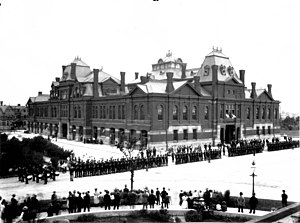
Back إضراب بولمان Arabic Pullman-strejken Danish Pullman-Streik German Pullman-striko Esperanto Pullman greba Basque Pullmanin lakko Finnish Grève Pullman French שביתת פולמן HE Pullman-sztrájk Hungarian Sciopero Pullman Italian
| Pullman Strike | |||
|---|---|---|---|
 Striking railroad workers confront Illinois National Guard troops in Chicago during the strike. | |||
| Date | May 11, 1894 – July 20, 1894 | ||
| Location | Began in Pullman, Chicago; spread throughout the United States | ||
| Goals | Union recognition Wage increase Rent reduction | ||
| Methods | Strikes, Protest, Demonstrations | ||
| Resulted in | Strike unsuccessful
| ||
| Parties | |||
| |||
| Lead figures | |||
| Number | |||
| |||
| Casualties and losses | |||
| |||
The Pullman Strike was two interrelated strikes in 1894 that shaped national labor policy in the United States during a period of deep economic depression. First came a strike by the American Railway Union (ARU) against the Pullman factory in Chicago in spring 1894. When it failed, the ARU launched a national boycott against all trains that carried Pullman passenger cars.[1] The nationwide railroad boycott that lasted from May 11 to July 20, 1894, was a turning point for US labor law. It pitted the American Railway Union (ARU) against the Pullman Company, the main railroads, the main labor unions, and the federal government of the United States under President Grover Cleveland. The strike and boycott shut down much of the nation's freight and passenger traffic west of Detroit, Michigan. The conflict began in Chicago, on May 11 when nearly 4,000 factory employees of the Pullman Company began a wildcat strike in response to recent reductions in wages. Most of the factory workers who built Pullman cars lived in the "company town" of Pullman just outside of Chicago. Jennie Curtis who lived in Pullman was president of seamstress union ARU LOCAL 269 gave a speech at the ARU convention urging people to strike.[2] It was designed as a model community by its namesake founder and owner George Pullman.[3]
As the Panic of 1893 weakened much of the economy, railroad companies ceased purchasing new passenger cars made by Pullman. When his company laid off workers and lowered wages, it did not reduce rents, and the workers called for a strike. Among the reasons for the strike were the absence of democracy within the town of Pullman and its politics, the rigid paternalistic control of the workers by the company, excessive water and gas rates, and a refusal by the company to allow workers to buy and own houses.[4] They had not yet formed a union.[3] Founded in 1893 by Eugene V. Debs, the American Railway Union (ARU) was an organization of railroad workers. Debs brought in ARU organizers to Pullman and signed up many of the disgruntled factory workers.[3] When the Pullman Company refused recognition of the ARU or any negotiations, ARU called a strike against the factory, but it showed no sign of success. To win the strike, Debs decided to stop the movement of Pullman cars on railroads. The over-the-rail Pullman employees (such as conductors and porters) did not go on strike.[3]
Debs and the ARU called a massive boycott against all trains that carried a Pullman car. It affected most rail lines west of Detroit and at its peak involved some 250,000 workers in 27 states.[5] The American Federation of Labor (AFL) opposed the boycott because the ARU was trying to take its membership. The high prestige railroad brotherhoods of Conductors and Engineers were opposed to the boycott. The Fireman brotherhood—of which Debs had been a prominent leader—was split.[6] The General Managers' Association of the railroads coordinated the opposition. Thirty people were killed in riots in Chicago alone.[7] Historian David Ray Papke, building on the work of Almont Lindsey published in 1942, estimated another 40 were killed in other states.[8] Property damage exceeded $80 million.[9]
The federal government obtained an injunction against the union, Debs, and other boycott leaders, ordering them to stop interfering with trains that carried mail cars. After the strikers refused, President Grover Cleveland ordered in the Army to stop the strikers from obstructing the trains. Violence broke out in many cities, and the strike collapsed. Defended by a team including Clarence Darrow, Debs was convicted of violating a court order and sentenced to prison; the ARU then dissolved.
- ^ A standard scholarly history is Almont Lindsey, The Pullman strike : the story of a unique experiment and of a great labor upheaval (1942) online
- ^ https://www.nps.gov/people/jennie-curtis.htm
- ^ a b c d "The Pullman Strike and Boycott". Annals of American History. Retrieved January 24, 2014.[permanent dead link]
- ^ Roark, James L.; Johnson, Michael P.; Furstenburg, Francois; Cline Cohen, Patricia; Hartmann, Susan M.; Stage, Sarah; Igo, Sarah E. (2020). "Chapter 20 Dissent, Depression, and War: 1890–1900". The American Promise: A History of the United States (Kindle). Vol. Combined Volume (Value Edition, 8th ed.). Boston, MA: Bedford/St. Martin's. Kindle Location 15016. ISBN 978-1319208929. OCLC 1096495503.
- ^ "Pullman Strike | United States history". Encyclopedia Britannica. Retrieved November 16, 2017.
- ^ White (2011) p 436.
- ^ Ray Ginger; et al. (1962). Eugene V. Debs. Macmillan. p. 170.
- ^ Papke, David Ray (1999). The Pullman Case: The Clash of Labor and Capital in Industrial America. Landmark law cases & American society. Lawrence, Kansas: University Press of Kansas. pp. 35–37. ISBN 978-0-7006-0954-3.
- ^ John R. Commons; et al. (1918). History of Labour in the United States. Vol. 2. Macmillan. p. 502.
© MMXXIII Rich X Search. We shall prevail. All rights reserved. Rich X Search